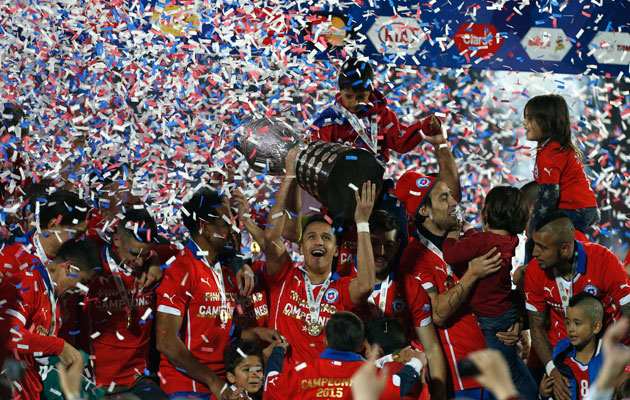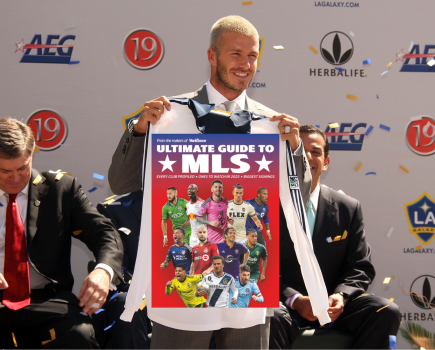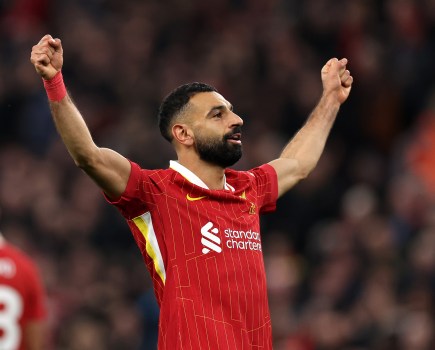Where next for Jorge Sampaoli? Although he has a contract to stay on as Chile coach until the 2018 World Cup, he hinted after the Copa America Final that he may look to move on.
And he could hardy be blamed for doing so, because what he has achieved with Chile is remarkable.
From a financial point of view, Sampaoli is unlikely to ever be in a better negotiating position. But, from an emotional point of view, Chile’s 99-year wait for a trophy with a win over his own native country, in a stadium where he achieved such success with Universidad de Chile, is unlikely to be topped. For, more than anything, Chile’s triumph was Sampaoli’s triumph.
It’s true that the foundations of this triumph were laid by Marcelo Bielsa, who was coach between 2007 and 2011, but after Claudio Borghi’s disappointing reign, there was still plenty of work to be done.
Sampaoli, to a degree because of a lack of choice, kept the existing squad together and generated a spirit that was as near as it is possible to get in a national side to a club environment.
The basics of the way Chile played were no great surprise. They pressed hard and high, using Marcelo Diaz at the back of midfield to drop between the centre-backs and switch from a back four to a back three and release the full-backs. Arturo Vidal and Charles Aranguiz both worked exceptionally hard in midfield, their tactical intelligence vital to a system that switched between 4-3-3 and 3-4-1-2. At the front, the shape replicated the back with Jorge Valdivia, so often such a frustrating player, operating behind a strike pairing of Alexis Sanchez and Eduardo Vargas, whowould often split to allow him to advance between them. The result was a highly fluid style that produced by some way the most attractive football of the competition.
What was most impressive was how Chile – with the exception of a nervy semi-final against Peru – kept on correcting flaws. In the opening game, a slightly anxious 2-0 win over Ecuador, for instance, Jefferson Montero again and again exploited the space behind Mauricio Isla, while Chile seemed heavily focused on attacking down their right. That bias disappeared thereafter and, after another shaky game against Mexico, no other left-winger really threatened to get in behind Isla, or at least not with the consistency Montero had.
A 3-3 draw with Mexico was more worrying for two other reasons, though. Firstly, that the Mexicans dominated a far shorter Chile side in the air, twice scoring with headers, and secondly that their third goal came from an extremely simple pass over the top because the Chilean back
line had pushed up when there was no pressure on the ball.
The latter issue is why few international sides play a pressing game: it requires a cohesiveness that is extremely hard to generate when players are not playing and training together every week. Sampaoli, though, presumably with further drilling on the practice pitch, ironed out the glitch.
The issue of height is rather different. Chile were the shortest team in the tournament, with an average height of 1.76m. There is not a huge amount that can be done about that, but Sampaoli was so worried about the threat that Uruguay posed from set-pieces that he strung up a tape 2m above the ground and had his players practising winning headers above that mark.
As it turned out, Chile defended extremely well against Uruguay. The goalkeeper, Claudio Bravo, was notably proactive about coming for crosses, and while Gonzalo Jara’s provocation
of Edinson Cavani will always leave a sour taste, that was probably their best performance of the tournament.
Against a resolute defence they stuck to their attacking principles, with Valdivia capping a superb performance by retaining his cool as a Fernando Muslera punch came to him on the edge of the box and calmly laying the ball off for Isla to score – a moment that, after the wobbles of the first two games, demonstrated the advantages of having a full-back surging forward late to join the attack.
But it was in the Final that Sampaoli really came into his own. Chile and Argentina had been the two sides with the most possession in the competition; for one or both that was clearly about
to change.
Argentina had looked much more dangerous in the tournament when they had had space to attack behind the opponent, as happened in both games against Paraguay (even in their opening group game, when they suffered a tactical collapse to squander a 2-0 lead and draw 2-2 they were still creating chances at the end). Given Chile’s preference for a high line, that seemed to pose a major problem and there were moments early in the match when Lionel Messi found space behind the left-back Jean Beausejour.
Messi, after a devastating performance in the semi- final, had been Sampaoli’s focus. Chile’s coach had reportedly spent the days before the Final watching videos of Messi while his players used a PlayStation4 to try to find a solution.
Remarkably, they did. Diaz played so deep in the Final that he was almost a third central defender. Francisco Silva came in to his right with Gary Medel swapped to the left of centre so he could push out and close Messi down, knowing he had Diaz behind him as protection. Aranguiz, on the left of the two shuttling midfielders, never let Messi get too far away from him, while Valdivia must have done more defending than in any other game in his career, forever pulling left to offer further protection. By the time Valdivia was replaced by the spikier
Mati Fernandez, Messi was already a diminished, demoralised figure.
Perhaps it would not have worked with a referee less prepared to let robust challenges pass or had Angel Di Maria not pulled up with a hamstring injury, but hypotheticals can play both ways.
The fact is that Sampaoli honed Chile over the course of the tournament and devised specific plans for specific games that worked. His combative style rubs some up the wrong way, but this was Sampaoli’s tournament.
By Jonathan Wilson







